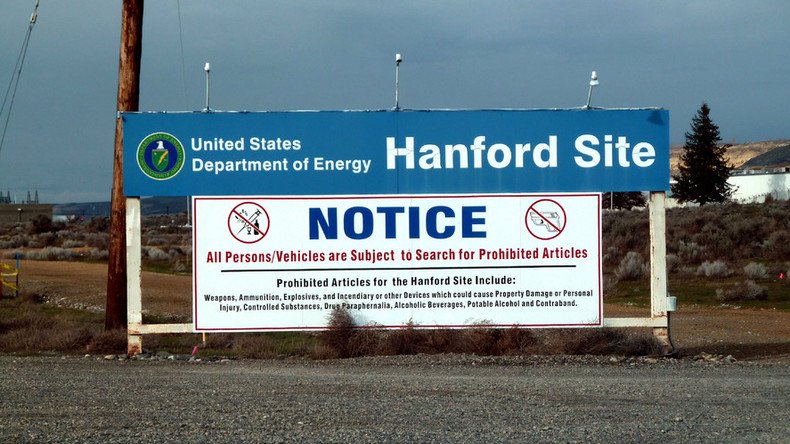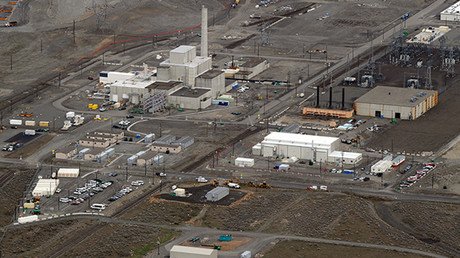Hanford Site not ‘controlling what comes out of nuclear waste tanks to protect workers’ – public

One of the Hanford Site tank farms that holds high-level nuclear waste was evacuated due to reports of an odor in the area. It may be the same type of leak that released toxic chemical vapors that injured dozens of workers in the last two weeks.
The “odor event” occurred at the TX tank farm at the beleaguered nuclear site in Richland, Washington on Tuesday morning. Three workers had completed “routine maintenance” outside the single-shell tank farm when two of them reported smelling an odor, according to the Department of Energy’s Office of River Protection at the Hanford Site. As part of standard procedure, the employees “exited the immediate area where the odor was reported, and access to that area as well as the TX tank farm was restricted.”
DOE statement on today's odor event at #Hanford tank farms @keprtv@SFrameK5@russ_walker@KNDOTV@JHalvorsonNewspic.twitter.com/ABKuhuXmOz
— DOE River Protection (@RiverProtection) May 10, 2016
The office stressed that the overall site was not evacuated, however. Instead, industrial hygiene technicians were called in to the specific area around the TX tank farm to collect air samples to be analyzed.
Two contract electricians went to the onsite medical clinic after their exposure, television channel KING’s Susanna Frame reported. This brings the total number of Hanford workers seeking medical treatment for exposure to chemical vapors to 49 in the last two weeks.
The release of toxic vapors are a localized problem, affecting only the workers. But Hanford has another problem, one that has reached surrounding towns: The site sometimes “burps” radiation into the atmosphere.
“[Hanford] should be controlling what comes out of high-level nuclear waste tanks, of course, to protect the workers,” State Representative Gerry Pollet told RT America’s Alexey Yaroshevsky. “Their lungs are destroyed, we’ve seen their brains destroyed from the chemicals and now we’re seeing that this does affect the general public.”
Pollet reached out to RT after Yaroshevsky’s report on Friday about a spike in radiation at Hanford. Pollet also serves as the executive director of Heart of America North West, a Hanford watchdog. He analyzed a chart from the Environmental Protection Agency (EPA) that shows a sharp spike in gamma radiation on Friday morning.
The readings show the random jump when the toxic fume rates briefly reached about 410 counts per minute (CPM), nearly the highest possible level. That equals to around 4 microsieverts (uSv) per hour, a common measurement of radioactivity. To put this into perspective, the single lifetime human dose should be between 0.71 uSv/hour and a maximum of 5.7 uSv/hour, according to Radiation Survival.
There have been 14 such burps so far in 2016, and the problem, according to Pollet, is that these burps are not counted towards the maximum radiation dose that the general public is allowed to be exposed to each year.
That dose is defined as the level at which one adult out of every 10,000 who would be exposed to this level of contamination in the air would be expected to die of cancer if they’re exposed every year. Yet the Hanford Site has claimed “for many years” that its airborne emissions of radiation are at a fraction of that allowable limit, Pollet noted.
“What’s clear to me now is that ‒ based on your reporting ‒ we’ve discovered that the regulatory limit and annual reporting has failed to take into account the ‘burps’ from the high-level nuclear waste tanks, and they have not been using the EPA RadNet data that you reported,” Pollet said.
The average year could have 25 such radiation burps, which Pollet described as “probably a good, conservative number.”
“If you had 25 spikes at the level at which you had on May 5, you’d exceed the total annual radiation dose for the public. And that’s very worrisome,” he said. “The fact of the matter is that most of the spikes were far, were about half the size of May 5’s spike. But that just means that if you have 40-50 such spikes, which is probable at this point, then you’re exceeding the limit.”
Saturday’s post-spike readings from EPA showed that the radiation level was at around 210 CPM. While it’s half the level it was during the height of the burp, it’s still a lot higher than should be present in the human body.















